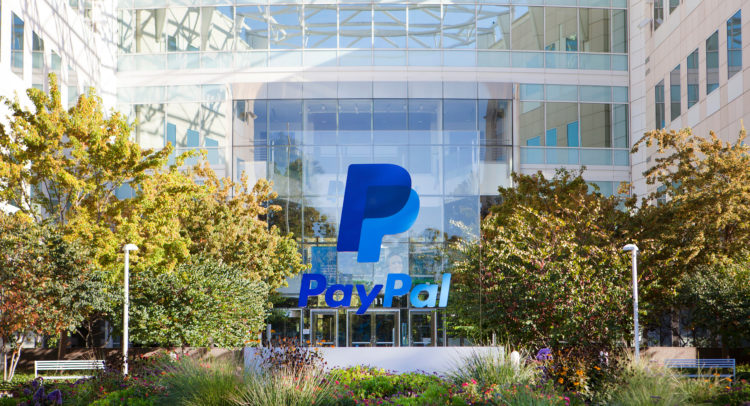PayPal Holdings (PYPL) is one of the most recognized player in the fin-tech space. The company’s goal is to allow its merchants and consumers to handle and transfer their money anywhere in the world, at any time, on any platform, and using any device when sending or receiving payments.
PayPal’s international, two-sided network has expanded substantially over the past decade, now numbering 426 million active accounts, including 392 million consumer active accounts and 34 million merchant active accounts.
The company has seen increased traction in its P2P payment solutions, which include the namesake PayPal platform, Venmo, and Xoom products and services. Other solutions in its ecosystem include PayPal Credit, Braintree,, iZettle, and Hyperwallet.
Historically, Paypal has leveraged its high-margin business model, through which the company has achieved consistent growth in the rapidly developing fintech industry. However, concerns regarding PayPal’s growth slowing down have been elevated lately. PayPal’s valuation during mid-2021 was pricing the company for hyper-growth ahead. With slowdown concerns actually materializing lately, the stock has lost around two-thirds of its value from its 52-week highs.
In my view, despite the stock’s violent sell-off over the past several months, PayPal still doesn’t present an attractive investment opportunity. Management’s latest guidance was underwhelming, while competition in the fintech space has been rising exponentially. Hence, PayPal stock may have more room to decline. I am neutral on the stock.
Growth Is Slowing Down
PayPal’s growth trajectory since its public listing had been relatively potent until recent years. However, it now appears to be decelerating lately, as demonstrated in its latest results.
Total Payment Volume (TPV) during Q4 reached $339.5 billion, with PayPal’s ecosystem counting 426 million active accounts.
Specifically, TPV grew 23% on an FX-neutral basis, while net revenues came in at $6.9 billion, just 13% higher on both a spot and FX-neutral basis. Net new active accounts adds were 9.98 million, also lower than the previous quarter’s 13.3 million adds.
Further, with PayPal undertaking some additional expenses during the year, Q4 adjusted earnings per share were also rather weak, growing by just 4% to $1.11.
Slowdown signs were evident across the board, even in some of PayPal’s fastest-growing segments. Venmo, one of the company’s most promising, hyper-growth assets, processed around $60.6 billion in TPV during Q4, suggesting a growth of 29% year-over-year. While this sounds rather fine at first glance, it indicates a significant and snappy deceleration from the previous quarter’s 36%.
Management’s guidance for fiscal 2022 further confirmed that Q4’s figures were not a temporary setback, but in fact, PayPal’s 20%+ growth days are unlikely to remerge. The company forecasts fiscal 2022 revenue growth to be between 15% and 17%, further declining from last year’s 18%. TPV is also expected to grow between 19% and 22%, again notably lower than fiscal 2021’s 33% gain.
Competition & Valuation
PayPal is, without a doubt, the most established and trusted platform to accept payments. However, I think I speak for most business owners when I state that PayPal’s take rates are just too high. As a business owner myself, I recently proposed to some clients previously paying us via PayPal to switch to Wise, whose overall fees have ended up being significantly lower.
PayPal’s authority in the space is likely to soften as competition gains. Fintech funding increased by 169% last year to $131.5 billion – a new record for the industry. Thus, it is more than likely that PayPal will have to lower its take rates if it wants to safeguard its user base from competition over the long term. Consequently, profitably growth is likely to stagnate in the near term. Management’s guidance for this year targeted adjusted EPS between $4.60 and $4.75, implying a year-over-year of just 1.7% at the midpoint.
Assuming adjusted EPS close to $4.68, the stock is trading at a forward P/E of around 22.6. Sure, this is a rather attractive multiple for a fintech company growing double-digits and one of the lowest multiples the stock has traded at since its public listing. However, with uncertainty over earnings growth rising going forward, it doesn’t necessarily suggest that the stock has bottomed.
Wall Street’s Take
Turning to Wall Street, PayPal has a Strong Buy consensus rating based on 29 Buys, ten Holds, and one Sell assigned in the past three months. At $174.86, the average PayPal Holdings stock forecast implies 70.91% upside potential, nonetheless.

Takeaway
Since last summer, PayPal stock has plunged massively, with investors’ worries over growth deceleration indeed surfacing. While the company remains a fintech juggernaut that is likely to retain double-digit top-line growth in the medium-term, competition could eat a portion of its bottom-line growth prospects.
Hence, despite the fact that shares could be more or less fairly valued following the stock’s prolonged decline, I wouldn’t rule out the possibility of further losses ahead. Moreover, with PayPal suspending its operations in Russia, I wouldn’t be surprised if the current fiscal 2022 guidance were to get downgraded during Q1’s earnings release, further upsetting investors.
Accordingly, I remain neutral on the stock.
Discover new investment ideas with data you can trust
Read full Disclaimer & Disclosure









